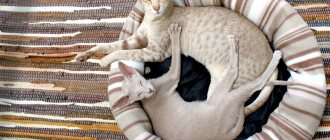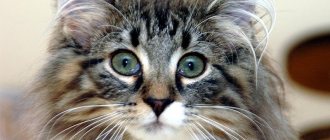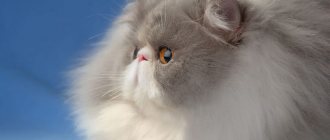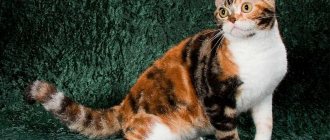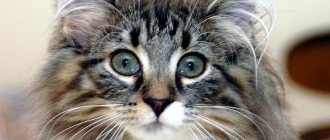Thais have six main colors:
- Seal Point - seal point (dark, “seal”).
- Blue point - blue point (blue).
- Chocolate point - chocolate point.
- Lilac point - lilac point (lilac).
- Red point - red point (red, red).
- Cream point - cream point (cream).
By “point” we mean not a solid color, but a dotted color. Thai cats have a white coat as their main coat color. Depending on their color, certain parts of their body are painted a darker shade:
- “mask” on the nose, eyes, parts of the cheeks and forehead;
- ears;
- legs;
- Feet;
- back;
- tail.
It is interesting that the “point” coloring does not immediately adorn “Thais” - they are born white. Color appears only in the first year of life. Its development does not stop there - the cat continues to darken a little with age.
Seal Point
This color is the most traditional and most common among Thai cats. The first “Thais” brought to Europe and exhibited in the Crystal Palace (London) were precisely “seal points”. Such cats have a whitish, soft beige, soft cream base coat tone and dark brown, or even almost black, dotted color.
Photos of Thai seal point cats:
What breeds can have color point color?
First of all, this look is typical for Siamese and Persian cats, but nowadays breeders have been able to obtain this coat color from representatives of other breeds. These include:
- ragdoll;
- Burmese;
- snow-shoe;
- Neva Masquerade;
- ocicat;
- Scottish;
- ;
- munchkin.
Neva Masquerade
Color Point is an interesting and attractive breed that comes in many different shades. This coat color is currently found in many breeds. Including the British.
To maintain the correct shade of markings, cats require special conditions.
But this only applies to show animals.
Blue Point
This beautiful color is genetically a “weakened”, “diluted” version of the seal point. Its bearers have a cold, icy base coat color, sometimes combined with a bluish "patina" on the back. As for the “points,” they are light gray, dark silver, almost blue.
The first owners of the suit were recorded in London back in 1896. Then Thais with blue points were disqualified from the felinological exhibition, although animals of a similar color were seen more than once in their homeland, in Siam. The Blue Point gained more and more fans - in 1934 the color was finally included in the breed standards.
Photos of the “Thais” Blue Point:
Blue point color and character
There is an opinion (not a proven fact) that the Blue Point Scotsman is a cat with character. The fact is that the blue colors of the Scots were originally obtained from British cats, known for their temper. Modern Scottish Folds and Blue Point Scottish Straights are somewhat similar in character to the British: they are independent, willful, and can be aggressive if they don’t like something. However, the degree of expression of these qualities depends on the presence of British cats in the immediate family. If there are a lot of British people in the document, you should expect a tougher character, and vice versa. However, British genes will still be softened by Scottish ones, so such cats are more sociable and kinder than their British counterparts.
Chocolate point
These Thai cats have a basic coat tone that is warm, milky, and ivory. The pattern on the face, paws, ears, tail, back is cold chocolate of varying intensity, reaching almost black.
The first “chocolate bars” were shown at exhibitions back in the 1880s. But the breeders did not consider this color to be independent - they took it for a “weakened” version of seal point. It got to the point that Choco Point cats were sterilized so as not to “spoil the breed.”
The cultivation of “chocolate” began only in the 1930s. The suit was officially recognized in 1950.
Photos of Thai Choco Point cats:
Bicolors
Bicolor cats have a coat that combines white with other tones. In purebred animals, the pattern on the body is located symmetrically. Common bicolor varieties include spotted and striped.
Calico
The calico pattern is a combination of white with tortoiseshell or tabby. Among cat lovers, individuals whose fur resembles a Harlequin costume are highly valued - a predominance of white on the body in addition to black (the top of the head and ears).
Wang
The name van was given to individuals whose tail is a different color than the body. Sometimes there are colored markings on the head.
Lil point
“Lilac” is a “weakened” variation of shock point. It seems that the owner of the color has a fur coat that is not just white, but with some violet or lilac tint. As for the dark zones, it is light gray with a pinkish, lilac tint.
The first "Lavender Point" was presented at an exhibition in Great Britain in 1896 - the animal was disqualified by conservative judges. The suit itself was recognized as official and independent only in 1960.
Photos of “lilac-point” color carriers:
Scottish Blue Point cats
The color of blue point Scottish cats (translated from English as “blue-point” means “blue dot”) is very beautiful. These are completely unique shades of light fur - the main color and shading on the paws, muzzle, ears and tail. Many people want to get just such a cat, because she is fabulously cute.
The blue point color is associated with the phenomenon of acromelanism - the dependence of the intensity of coat coloring on temperature: in places where the body temperature is higher, the coat is lighter, and vice versa. While colorful kittens are in the mother’s belly, they are completely light, because their body temperature is uniform. But within a few days after birth, Scottish Blue Point kittens begin to darken their paws, tail, face and ears due to the fact that the temperature of these parts of the body is lower than the rest. This effect is associated with the action of the enzyme tyrosinase, which is responsible for the synthesis of pigments. By the way, for the same reason, colorful cats can change color slightly depending on the air temperature - sometimes darker, sometimes lighter. In addition, this color changes with age.
The color gene in cats determines not only the color of the coat, but also the eyes, which remain blue without changing to golden in adulthood. Blue eyes are the dream of almost every cat owner. And the main thing is that in this case the blue-eyed gene is not associated with deafness, as happens in pure white murkies. As a result, we have unique shades of eyes and fur, which, as a rule, are liked by absolutely everyone, even those who can’t stand Chocleate Point cats (“chocolate point”), which are associated with Siamese and create the impression that they stuck their muzzle in chocolate.
Red point
In cats with red dot coloration, the main color of the “fur coat” varies from white to delicate cream. “Point” is not universal for all cats: some are yellowish-gray, some are reddish, orange, some are dark red, almost carrot-colored. The nose and paw pads are dark pink.
The first "Thai" red point was demonstrated in 1934, but they did not receive recognition. Their selection began only in the 1940s in the USA and Great Britain. Many breeders were alarmed by the fact that the color was not “pure” - bred from crossing a Thai cat with a half-Thai cat. However, after many years of breeding, in 1973, the “red point” was finally recognized as a breeding color.
Photos of Thai Red Point owners:
Who are Thai cats?
So who are they: Thai or Siamese? This confusion for many of us dates back to deep Soviet times, when the Siamese stood out brightly among the very poor cat mongrel: some kind of unearthly grace, a color unlike anyone else, sapphire eyes... Horror stories and fables were invented about strange animals, although they there was no particular need for that - Siamese cats (and this was them) have so many legends in their arsenal of history that other breeds could not even dream of.
Old Siamese cats are like this
For a long time, keeping these cats was considered the exclusive privilege of the kings and high nobility of Siam, and their export from the country was prohibited at the state level. The first Siamese cats, by hook or by crook, appeared in Europe only in the nineteenth century. They are described as strong and round-cheeked animals of an acromelanic color - this is what we today call the color point color.
Siam is simply the ancient name for Thailand. And modern Siamese cats are strikingly different from those that were once so popular in our country. The fact is that the breed developed quite quickly and in two directions at once, and breed standards also changed significantly. The old-type Siamese cats that are familiar to us are now called Thai.
Thai (left) and modern Siamese (right) cats: feel the difference
In comparison, modern (new type) Siamese have changed almost beyond recognition - these two lines of the breed developed in parallel, and in 1991 traditional (old type) Siamese cats received the status of a separate, Thai breed and the WCF standard. In the USA, “former Siamese” are often called old-style or appleheads Siamese.
The official standard describes Thais as “contrasting cats with Siamese points” - strong but elegant, with a rounded head and low, strong paws. Almond-shaped eyes - only deep blue. The coat is silky, without undercoat and white spots.
Video: Thai cat breed
Cream point
“Cream” is a genetically weakened variation of the “red point”. These cats have a creamy white body and pastel, creamy “points.” The nose and pads are pink.
The color was recognized as breeding in 1973. In 1977, “cream points” were officially allowed to participate in exhibitions.
Photos of “Thai” cream point:
Features of color point color
The color point color in cats has a number of characteristic features:
- Colorpoint kittens are always born white or light cream in color, but after a couple of days the first dark spots form on the limbs, tail and face, which become more and more numerous as the kitten grows - this is due to the fact that the development of kittens took place in the mother’s womb, where consistently warm. As soon as babies are born, when the temperature drops, the work of the coloring pigment is activated, and the color begins to change.
- A guaranteed color point kitten can only be obtained as a result of the union of two color point parents - in this case, every single kitten will be point. But there is an interesting exception - one or both parents can only be carriers of the cs gene, while being of any other color. Then some of the kittens will also be color point.
- The intensity of the color depends on the ambient temperature - the lower it is, the brighter and darker the color of the pet's fur will be.
- The color gene is closely related to eye color - it must certainly be blue, regardless of the breed of the cat. The brighter the eye color, the more intense and clearer the cat's color is.
What types of color point breeds are there?
Siamese and Thai cats are one of the few cats whose standard means only color point color. But there are many breeds that, in addition to the traditional solid colors, are allowed to have such an attractive Siamese outfit.
- Persian color point. The first successful experiments in obtaining colored pointing cats besides Siamese happened with Persians - this happened as a result of crossing Persian and Siamese cats. The luxurious thick fur of these animals requires considerable care.
- British color point. The first representatives of this variety of British cats were bred relatively recently; breeding them is not an easy task, which is why such kittens are highly valued among breeders.
- Scottish Straight - the darkened areas of the body of representatives of this breed look as if in a light haze. The color came into this breed as a result of crossing with Persians and the British. Very beautiful and impressive cats with an excellent docile character.
- Neva Masquerade. In other words, these are color point Siberian cats. They were first bred in St. Petersburg as a result of the union of Siberians with the same Siamese. The breed is stunning with its beauty - a powerful large body, luxurious thick fur, inherited from its Siberian relatives, harmoniously combined with the Siamese color and sky blue eyes.
- This color is also allowed for all varieties of sphinxes - Canadian, Don and Peterbalds. Due to the lack of hair in these cats, the skin has a color-point color.
This is not a complete list of breeds; there are also other, rarer representatives of the cat world that are not very well known in our country - these are breeds such as snowshoe, ragdoll, Burmese and others.
Caring for color point cats
In addition to observing the temperature regime, when caring for Color Point cats, you should follow some rules to prevent significant darkening of the coat.
There are a number of products that, according to the observations of experienced breeders, affect the color of the coat for the worse, among them: carrots, iodine-containing products, products with a large amount of copper in their composition - liver and other by-products, buckwheat, oatmeal, seafood - all this should be avoided in the diet, especially when feeding purebred show animals. If desired, owners can choose special ready-made food for such a cat, created taking into account the characteristics of its color.
Long-haired cats should be thoroughly brushed daily - if the hair becomes matted to such an extent that it has to be cut, the color will inevitably darken at the site of the bald spot. For the same reason, it is worth avoiding various types of operations and injuries if possible. Sometimes after molting the color is restored, but, unfortunately, this cannot be guaranteed. If surgery is necessary for an animal, you should try to choose an inconspicuous location for the future seam and keep the operated area well insulated until the fur grows back.
New colors
In addition to the traditional ones, there are also new, unusual colors of “Thais”, however, recognized by the breed standards.
Torty point
The name of the color literally translates as “tortoiseshell point”. This is a tortoiseshell color, which appears only on the traditional Thai “points”. Here are the correspondences:
- red goes with chocolate, dark;
- cream - with blue, lilac.
The color of the pads and nose corresponds to the spreading color: where the dark coat is black skin, where the light coat is pink skin.
The color is called exceptional because of two features:
- each “turtle” has its own unique arrangement of spots on the “points”;
- Most “cakes” are cats.
The color was officially recognized in 1971.
Photos of tortie point cats:
Tabby point
The color is in many ways reminiscent of a traditional seal point, however, the “points” are not solid, but striped in color. The color cannot be called pure - it appeared by crossing with European shorthairs. But the “lynx point” was officially recognized in Great Britain in 1966.
Photos of “Thai” tabby point:
Torty tabby point (tarby point)
An interesting color: on the “points” tabby (stripes) and torby (tortoiseshell coloring) coexist. The color combination is as follows:
- red - with chocolate, “seal”;
- cream - with lilac and blue.
The color was recognized in 1973.
Photo of the owner of the tortie-tabby-point color:
Golden Tabby Point
The main color of the body is ivory and cream. The points have golden-brown stripes. At the same time, the ears and the tip of the tail are black, and on the forehead the stripes form the letter “M”. The nose can be pinkish-brown or salmon-colored. Today, the suit is bred only in Russia and Italy.
Thai golden tabby point cat:
Caring for point cats
In general, care for point cats is the same as for cats of other colors. But it has its own characteristics.
Point cats cannot be cut or shaved: this leads to the appearance of darker areas of the coat. In the photo below you see the “panties” of a point cat, which formed after shaving before sterilization. This feature of this color, of course, does not mean that a Point cat cannot be operated on: a mark on the stomach does not make the animal less beautiful, because it is practically invisible. But, if you trim your cat's entire hair or in prominent places, or shave it, this can cause it to become dark throughout the body, and this will ruin its appearance.
Inept use of a fruminator when combing can also lead to bad consequences, because... With this tool it is easy to damage and cut off hairs, resulting in the undesirable effect of darkening the fur. If you do not know how to use a furminator, it is better to opt for a special paw for combing cats.
Also, the color of the point, as we said above, reacts to the ambient temperature: the lower it is, the darker the marks, and vice versa - in the heat, many cats become significantly lighter. Accordingly, don’t be surprised if your cat looks a little different depending on the time of year. The ideal temperature for keeping points is +25 degrees.
It is worth considering that the blue point color is a light color, and therefore easily soiled: dust and dirt in the house, settling on the fur, will spoil the appearance of the cat. Even if she is washed regularly, you will notice that the color becomes more interesting after a bath. This statement is not a call to endlessly bathe your pet, but advice on how you can improve the color if you suddenly notice that it has worsened. If the cause was contamination, advice will help. Although there are many other reasons for the deterioration of color point colors.
To improve the color, you can bathe Blue Point cats whose bodies are not light enough with special lightening shampoos. However, if the cat’s markings, on the contrary, are weakly expressed, then there is no need to lighten the fur further. Then you can choose any shampoo based on the problem (if any) or a basic one. We are talking about professional shampoos. It is better to avoid mass-market shampoos.
Some owners notice that food also affects the color of Blue Points: beef, carrots, beets, liver and seaweed can darken the coat. However, this has not been scientifically proven, and along with the owners who noticed changes in color depending on the diet, there are those who do not see any changes.
In the end, we would like to add that the point color of Scottish and British cats is one of the most unstudied: probably, its quality is influenced by a greater number of genes than is currently known to felinologists. So far, among the British and Scots, standard-colored point cats that have retained the excellent morphological characteristics inherent in these breeds are a rarity. The point colors within these breeds will still undergo changes: breeders have a lot of work ahead of them.
Description and breed standard
All representatives of the Thai breed are beautiful and graceful. They are quite miniature and have good muscles. A Thai breed cat weighs on average 5–6 kilograms; cats are even smaller and are distinguished by their special grace. What types of standards apply to furry cats from Thailand:
- The head is round in shape. Drop-shaped or apple-shaped. There should be no sharp or sharp features.
- The muzzle is of medium length. The appearance is round.
- Most representatives of the Thai breed have blue eyes. Externally, the visual organ is almond-shaped, widely spaced.
- The characteristics of the breed are a proportionally developed body with well-defined muscles.
- The tail is neat, without creases, tapers towards the end and is not pointed.
- Purebred can also be determined by the animal’s paws. They are sturdy with soft, round pads.
- The Thai cat or female cat comes in a variety of colors from cream to pale blue. A distinctive feature remains dark spots on the face, limbs and ears.
Colors and coat of the Thai cat
The coat of Thai cats is silky, fine in texture with a medium-developed undercoat.
The most common color type is seal point. Fawn color, distinctive spots are dark, sometimes black. What other colors are there:
- Blue Point - deep gray with almost blue markings. Blue's nose, whiskers and pads are usually ashy.
- Chocolate Point - the fur color of the furry representatives is closer to white. A white cat has dark brown or milky brown markings.
- Lilac Point - the fur of Thai cats of this type has a crystal white hue, the markings appear dark purple.
- Red point is a cream-colored dog with red markings on the legs, ears and face.
- Tabby point - the tabby color is distinguished by the presence of stripes on the pet's tail, ears and paws. There are different subspecies of this color, seal tabby point has black stripes, blue tabby point has bluish-gray stripes. Seal point tabby cats appeared in Thailand relatively recently.
- The tortie color name refers to the tortoiseshell pattern.
Personality of the Thai cat
This is the smartest breed of the cat family. They not only catch mice, but are also trainable, active in play, and very affectionate.
Thai cats are very devoted to their owner, they patiently wait for him to return after work and are sincerely glad to see any kind of affection.
Many of those who own these cats said that they are good nannies. Thais are patient with children; they will never allow themselves to show aggression towards a child, even if he makes the cat uncomfortable.
Another side of the Thai breed's character is curiosity. They constantly strive to check every corner of the house and get into every package, which is why they often cause chaos. They love to play with their owner. In order for an animal to realize its energy, it must always have a lot of toys.
Features of care
Thais do not require special care. They are not picky eaters and are able to take care of themselves. Their fur does not get tangled, of course, if they do not run through the bushes. The animal does not shed much, just combing the coat during the molting period will be enough and there will be no problems with the fur in the house.
It is not advisable for a cat to carry out water treatments; like most pets, they do not like water.
Once a month, you should clean your pet’s ears to remove wax and other contaminants.
Health and life expectancy
Thais are a strong breed, they rarely get sick, so frequent visits to the veterinarian do not threaten the owners. However, do not forget about the necessary vaccinations and immunizations. Vaccinations for kittens begin at 2–3 months of age and then according to the established schedule. What diseases can appear in this breed:
- heart disease;
- cancer;
- tumor of the mammary glands - many females are susceptible to this disease;
- Diabetes mellitus is not a rare disease among Thai cats.
To maintain your pet’s health, do not forget about preventive examinations.
How long do Thais live? At home, representatives of this breed live up to 12–15 years. There are representatives who lived 25–28 years. And even at such an old age they are able to remain playful and cheerful.
What to feed a Thai cat
When selecting a diet, you can buy special food for your pet, according to the breed. However, Thais will not refuse a piece of meat, milk, fish, and sometimes they will gladly ask the owner for a melon or cucumber.
In any case, it is worth remembering that food should be fresh and balanced. Do not overfeed the animal. What may be included in the meal:
- beef meat;
- egg;
- chicken;
- low fat fermented milk products.
Fresh fruits and vegetables are also necessary for the animal. You can chop them and mix them with pieces of meat. Most of all they love meat products.
Breeding
Pregnancy before reaching one year of age threatens weak offspring and a threat to the health of the mother cat. The best option for breeding remains 1.5 years.
An adult cat prefers to meet his chosen one on his territory. Usually 3-5 days are enough for a cat to become pregnant.
You should choose a partner for your pet carefully, then the kittens will be born healthy and strong.
White color
White color is a complete lack of pigmentation. In cats, solid white fur can be achieved in three different cases:
White albino is a recessive variant that is very rare in cats.
Solid white spots - appear under the influence of the white spot factor (S), which is not completely dominant, is subject to polygenetic modifications and usually leads to the fact that the cat is not entirely white. However, the spots may be so dense that the animal appears completely white. White spots are described in the following sections.
Dominant White - This mutation suppresses all other pigmentation genes, and results in a white coat color and blue eyes. As the name suggests, this is the effect of the dominant white gene (W). In the case of dominant white, the genes for other colors and patterns, although present, are completely hidden. The only way to determine the main genotype in practice (before the appearance, conduct a genetic analysis to determine the genotype of the cat) is by crossing with colored cats of a well-known genotype. Breeding two dominant whites will usually result in all-white kittens, but if both parents are heterozygous (W/w), some kittens may show primary colors. If the genotype of the white parents is not known from the pedigree or test crosses, the mating result is unpredictable.
Dominant white is found in a variety of breeds. Sometimes white Oriental Orientals are considered by some associations as a separate breed. The dominant white color has a much deeper blue eye color than albinos, and this is considered an advantage. The best blue eye color is observed in completely white Oriental Oriental cats that carry a suppressed chocolate gene.
Deafness in cats is associated with the spotting (S) and white dominant (W) genes, but not with the albinism gene (c/c or ca/ca).
Strabismus in point cats
Cats of any point color (and there are not only blue, but also seal point, lilac point, lynx point and other variations) can experience convergent strabismus, which is characteristic of cats of the Siamese, Thai, Oriental and Burmese breeds. This defect, geneticists believe, is a byproduct of the action of the cs point gene.
Often in point cats you can find a violation of the projection of the optic nerves: part of the visual pathways from the eye goes to the side of the brain opposite to the norm. To compensate for this feature, strabismus appears, which allows the cat to build the correct visual picture.
However, there is an opinion that just one pair of cscs genes is not enough for the development of strabismus: additional genes are needed that lead to such a disorder. That is, to say that most point cats suffer from strabismus is incorrect: the majority of Scots point cats, in fact, do not have this problem.
